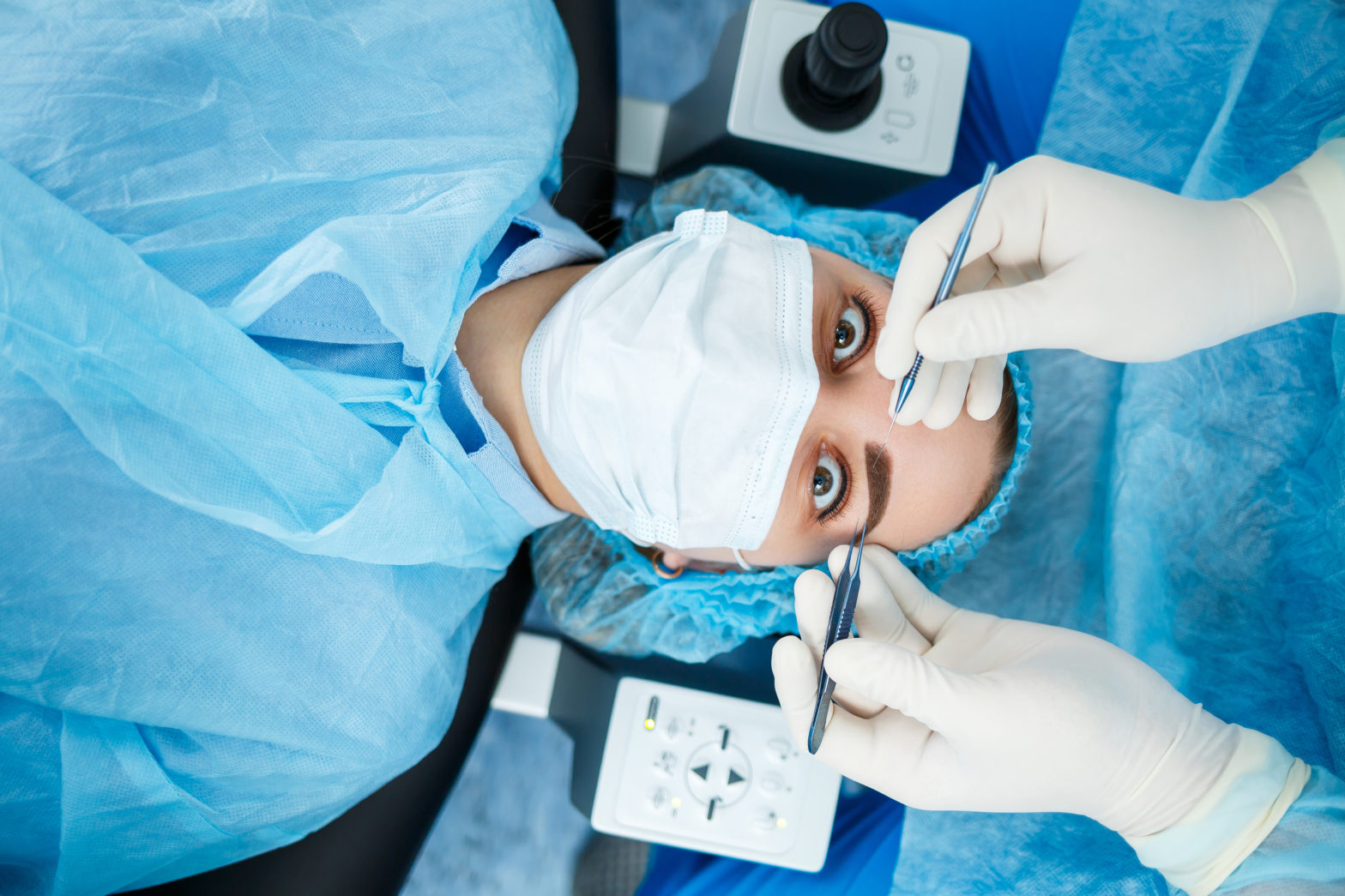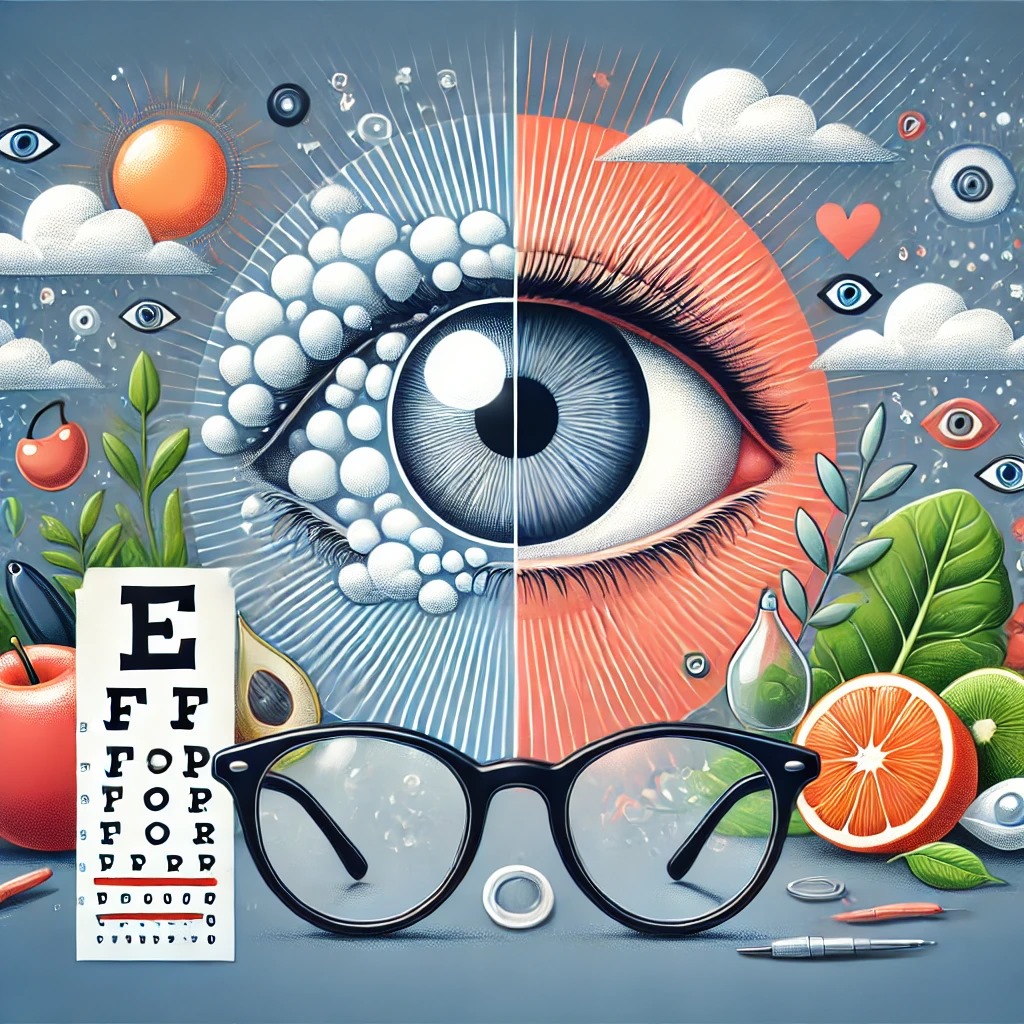मोतीबिंदू शस्त्रक्रिया ही एक जीवन बदलणारी प्रक्रिया बनली आहे, ज्यामुळे जगभरातील लाखो रुग्णांना स्पष्ट दृष्टी मिळते. तथापि, काही लोकांना नंतर दुष्परिणामांचा अनुभव येतो, ज्यामध्ये प्रकाश संवेदनशीलता - किंवा फोटोफोबिया - ही सर्वात सामान्य समस्यांपैकी एक आहे. ही संवेदनशीलता दैनंदिन क्रियाकलापांना आव्हानात्मक बनवू शकते, विशेषतः जेव्हा तेजस्वी किंवा फ्लोरोसेंट दिवे समोर येतात.
या ब्लॉगमध्ये, आपण मोतीबिंदू शस्त्रक्रियेनंतर प्रकाश संवेदनशीलता का येते यावर चर्चा करू, त्याच्या कालावधीवर चर्चा करू आणि मोतीबिंदू शस्त्रक्रियेनंतर तेजस्वी आणि फ्लोरोसेंट दिव्यांमुळे होणारा त्रास व्यवस्थापित करण्यासाठी धोरणे देऊ. ही प्रक्रिया समजून घेतल्याने रुग्णांना त्यांच्या पुनर्प्राप्तीमध्ये चांगल्या प्रकारे नेव्हिगेट करण्यास आणि प्रकाश संवेदनशीलतेभोवतीचा ताण कमी करण्यास मदत होऊ शकते.
मोतीबिंदू शस्त्रक्रियेनंतर प्रकाश संवेदनशीलता का येते?
मोतीबिंदू शस्त्रक्रिया प्रकाश संवेदनशीलता ही अगदी सामान्य आहे, कारण ती प्रक्रिया आणि उपचार प्रक्रियेशी संबंधित अनेक घटकांमुळे उद्भवते. मोतीबिंदू शस्त्रक्रियेदरम्यान, डोळ्यातील ढगाळ नैसर्गिक लेन्स कृत्रिम इंट्राओक्युलर लेन्स (IOL) ने बदलला जातो. जरी हे अत्यंत प्रभावी असले तरी, नवीन लेन्सशी जुळवून घेताना हे बदल तुमचे डोळे प्रकाशासाठी अधिक संवेदनशील बनवू शकतात.
प्रकाश संवेदनशीलतेमागील प्रमुख कारणे:
- उपचार प्रक्रिया: नवीन लावलेल्या लेन्सभोवती असलेल्या डोळ्याच्या ऊतींना बरे होण्यासाठी वेळ लागतो, ज्यामुळे प्रकाशाची संवेदनशीलता वाढू शकते.
- वाढलेले प्रकाश प्रसारण: मोतीबिंदू-ढगाळ लेन्सच्या तुलनेत कृत्रिम आयओएल डोळ्यात जास्त प्रकाश प्रवेश करू देते, ज्यामुळे संवेदनशीलता वाढते.
- विद्यार्थ्यांचे कार्य: या शस्त्रक्रियेमुळे बाहुली प्रकाशाला किती चांगला प्रतिसाद देते यावर तात्पुरते परिणाम होऊ शकतो, ज्यामुळे तेजस्वी दिवे तीव्र किंवा वेदनादायक देखील वाटू शकतात.
फोटोफोबिया म्हणजे काय? फोटोफोबियाचा अर्थ आणि त्याची सामान्य लक्षणे
फोटोफोबिया म्हणजे प्रकाशाच्या संवेदनशीलतेला सूचित करते, जिथे तेजस्वी प्रकाश डोळ्यांना अस्वस्थता किंवा वेदना देतात. हा आजार नाही तर डोळ्यांच्या आजारांचे किंवा न्यूरोलॉजिकल समस्यांचे लक्षण आहे. फोटोफोबिया असलेल्या लोकांना सूर्यप्रकाश, फ्लोरोसेंट दिवे किंवा अगदी स्क्रीनची चमक असह्यपणे तेजस्वी वाटू शकते, ज्यामुळे अस्वस्थता किंवा डोळ्यांवर ताण येऊ शकतो.
फोटोफोबियाचा अर्थ
"फोटोफोबिया" हा शब्द दोन ग्रीक शब्दांपासून आला आहे: "फोटो" म्हणजे प्रकाश "फोबिया" म्हणजे भीती किंवा तिटकारा. तथापि, फोटोफोबिया म्हणजे प्रकाशाची प्रत्यक्ष भीती नसून प्रकाशाच्या संपर्कात येण्याची वाढलेली संवेदनशीलता किंवा असहिष्णुता.
फोटोफोबियाची सामान्य लक्षणे
फोटोफोबिया असलेल्या लोकांना खालीलपैकी एक किंवा अधिक लक्षणे दिसू शकतात:
- तेजस्वी प्रकाशात डोळ्यांना त्रास होणे
सूर्यप्रकाश, एलईडी दिवे किंवा फ्लोरोसेंट बल्बच्या संपर्कात आल्यावर वेदना किंवा चिडचिड.
आत डोकावून पाहणे, डोळे बंद करणे किंवा सनग्लासेस घालणे आवश्यक आहे. - डोकेदुखी किंवा मायग्रेन ट्रिगर
तेजस्वी प्रकाशामुळे मायग्रेन किंवा तणावग्रस्त डोकेदुखी वाढू शकते.
कृत्रिम किंवा नैसर्गिक प्रकाशाची वाढलेली संवेदनशीलता. - डोळे पाणावलेले किंवा लाल होणे
प्रकाशाच्या संपर्कात आल्याने होणारी जळजळ जास्त प्रमाणात फाडणे.
डोळ्यांमध्ये लालसरपणा आणि जळजळ. - धूसर दृष्टी
प्रकाशामुळे होणाऱ्या अस्वस्थतेमुळे लक्ष केंद्रित करण्यात अडचण.
दिव्यांभोवती तात्पुरते दृश्यमान अडथळे किंवा प्रभामंडळ. - डोळ्यांचा ताण आणि थकवा
जास्त वेळ प्रकाशात राहिल्यानंतर थकवा किंवा अस्वस्थता जाणवणे.
डोळ्यांमध्ये जळजळ किंवा वेदना जाणवणे.
फोटोफोबियाची सामान्य कारणे
फोटोफोबिया विविध वैद्यकीय परिस्थितींमुळे होऊ शकतो, ज्यात हे समाविष्ट आहे:
कोरडे डोळे - डोळ्यांमध्ये ओलावा नसल्यामुळे प्रकाशाची संवेदनशीलता वाढू शकते.
मायग्रेन - प्रकाश हा मायग्रेनचा एक सामान्य ट्रिगर आहे.
डोळ्यांचे संक्रमण (कंजुंजक्टिवायटिस, युव्हिटिस, केरायटिस) - जळजळ प्रकाश संवेदनशीलतेस कारणीभूत ठरते.
कॉर्नियलचे नुकसान - कॉर्नियावर झालेल्या दुखापती किंवा ओरखडे यामुळे तेजस्वी प्रकाशात अस्वस्थता येते.
अपवर्तक त्रुटी - मायोपिया किंवा दृष्टिवैषम्य यासारख्या अदुरुस्त दृष्टी समस्या फोटोफोबियामध्ये योगदान देऊ शकतात.
न्यूरोलॉजिकल स्थिती - मेंदुज्वर, मेंदूला दुखापत किंवा जास्त स्क्रीन वेळ यासारख्या समस्या मेंदूला प्रकाशासाठी अधिक संवेदनशील बनवू शकतात.
फोटोफोबिया कसा नियंत्रित करायचा?
बाहेर पडताना अतिनील किरणांपासून संरक्षण असलेले सनग्लासेस घाला.
स्क्रीनची चमक कमी करा आणि निळ्या प्रकाशाचे फिल्टर वापरा.
जर डोळे कोरडे पडत असतील तर कृत्रिम अश्रू वापरा.
गरज पडल्यास मंद प्रकाश असलेल्या वातावरणात रहा.
जर फोटोफोबिया सतत किंवा तीव्र असेल तर नेत्ररोग तज्ञांचा सल्ला घ्या.
फोटोफोबियाचा दैनंदिन जीवनावर लक्षणीय परिणाम होऊ शकतो, परंतु कारण ओळखणे आणि प्रकाशाच्या संपर्कात येणे व्यवस्थापित करणे अस्वस्थता कमी करण्यास आणि डोळ्यांचे आरोग्य सुधारण्यास मदत करू शकते.
मोतीबिंदू शस्त्रक्रियेनंतर फोटोफोबिया: तो किती सामान्य आहे?
मोतीबिंदू शस्त्रक्रियेनंतर फोटोफोबिया होणे हे रुग्णांमध्ये सामान्य आहे. संवेदनशीलतेची पातळी वेगवेगळी असली तरी, सुरुवातीच्या पुनर्प्राप्ती कालावधीत तेजस्वी दिवे आणि फ्लोरोसेंट दिवे सारख्या काही कृत्रिम प्रकाश स्रोतांच्या संपर्कात आल्यावर बहुतेकांना अस्वस्थता जाणवते.
प्रकाश संवेदनशीलतेचा सामान्य कालावधी:
- पहिले काही दिवस: शस्त्रक्रियेनंतरच्या सुरुवातीच्या काळात, प्रकाशाची संवेदनशीलता तीव्र असू शकते, विशेषतः जेव्हा थेट किंवा तेजस्वी प्रकाश स्रोतांच्या संपर्कात येते.
- शस्त्रक्रियेनंतर २-६ आठवडे: डोळा बरा होत असताना, प्रकाशाची संवेदनशीलता हळूहळू कमी होते, जरी काही प्रकारचे प्रकाश अजूनही अस्वस्थता निर्माण करू शकतात.
- ६ आठवड्यांनंतर: बहुतेक रुग्णांमध्ये, प्रकाशाची संवेदनशीलता या वेळेपर्यंत कमी होते. तथापि, जर मोतीबिंदू शस्त्रक्रियेनंतर फोटोफोबिया कायम राहिला तर गुंतागुंत वगळण्यासाठी नेत्ररोग तज्ञाचा सल्ला घेणे महत्वाचे आहे.
मोतीबिंदू शस्त्रक्रियेनंतर होणारा फोटोफोबिया हा सामान्यतः तात्पुरता असतो, परंतु काही टक्के रुग्णांना दीर्घकाळात संवेदनशीलता जाणवत राहू शकते. प्रकाशाच्या संपर्कात येण्याचे समायोजन आणि संरक्षणात्मक उपायांमुळे ही संवेदनशीलता कमी होण्यास मदत होते आणि संक्रमण सुरळीत होण्यास मदत होते.
रुग्णांना अनेकदा येणाऱ्या प्रकाशसंवेदनशीलतेचे प्रकार
रुग्णांना विशिष्ट प्रकाश परिस्थिती इतरांपेक्षा जास्त त्रासदायक वाटू शकते, ज्यामध्ये सूर्यप्रकाश आणि कृत्रिम प्रकाश हे मुख्य कारण असतात. खाली सामान्य परिस्थिती दिली आहेतः
१. मोतीबिंदू शस्त्रक्रियेनंतर तेजस्वी दिवे
मोतीबिंदू शस्त्रक्रियेनंतर तेजस्वी प्रकाशामुळे अनेक रुग्णांना अस्वस्थता वाढते. ही संवेदनशीलता, विशेषतः थेट सूर्यप्रकाशाची, ही सर्वात जास्त नोंदवल्या जाणाऱ्या लक्षणांपैकी एक आहे. मजबूत यूव्ही संरक्षणासह सनग्लासेस घालल्याने डोळ्यात येणाऱ्या प्रकाशाची तीव्रता कमी होण्यास लक्षणीयरीत्या मदत होऊ शकते.
२. मोतीबिंदू शस्त्रक्रियेनंतर फ्लोरोसेंट दिवे
काहींसाठी, मोतीबिंदू शस्त्रक्रियेनंतर फ्लोरोसेंट दिवे आव्हानात्मक असू शकतात. सार्वजनिक ठिकाणी, कार्यालयांमध्ये आणि रुग्णालयांमध्ये फ्लोरोसेंट दिवे बहुतेकदा वापरले जातात आणि त्यांच्या चमक आणि तीक्ष्ण तेजामुळे संवेदनशील डोळ्यांवर ताण येऊ शकतो. चमक कमी करणारे आणि विशिष्ट तरंगलांबी फिल्टर करणारे विशेष लेन्स पुनर्प्राप्ती दरम्यान फ्लोरोसेंट दिवे असलेले वातावरण अधिक आरामदायक बनवण्यास मदत करू शकतात.
३. स्क्रीन आणि डिजिटल उपकरणे
फोटोफोबियाचा आणखी एक सामान्य प्रकार म्हणजे स्क्रीन आणि डिजिटल उपकरणे. स्क्रीनमधून निघणारा निळा प्रकाश प्रकाशाची संवेदनशीलता वाढवू शकतो. स्क्रीन सेटिंग्ज समायोजित करणे किंवा निळा-प्रकाश-अवरोधक चष्मा वापरणे अस्वस्थता कमी करण्यासाठी प्रभावी ठरू शकते.
मोतीबिंदू शस्त्रक्रियेनंतर प्रकाश संवेदनशीलतेचे व्यवस्थापन
मोतीबिंदू शस्त्रक्रियेदरम्यान प्रकाश संवेदनशीलता ही निराशाजनक असू शकते, परंतु अनेक तंत्रे रुग्णांना अस्वस्थता व्यवस्थापित करण्यास आणि कमी करण्यास मदत करू शकतात. येथे काही व्यावहारिक टिप्स आहेत:
यूव्ही-संरक्षणात्मक सनग्लासेस घाला
१००१TP३T अतिनील किरणांना रोखणारे उच्च दर्जाचे सनग्लासेस खरेदी करा. हे तुमच्या डोळ्यांना तीव्र सूर्यप्रकाशापासून वाचवू शकते आणि मोतीबिंदू शस्त्रक्रियेनंतर तेजस्वी प्रकाशाच्या संपर्कात आल्यावर संवेदनशीलता कमी करू शकते. रॅपराउंड सनग्लासेस विशेषतः उपयुक्त आहेत कारण ते बाजूंनी येणारा प्रकाश मर्यादित करतात, ज्यामुळे अधिक आराम मिळतो.
मऊ घरातील प्रकाशयोजना निवडा
घरात कडक फ्लोरोसेंट दिवे टाळा, जे संवेदनशील डोळ्यांसाठी आव्हानात्मक असू शकतात. शक्य असल्यास घरी मऊ किंवा उबदार एलईडी दिवे वापरा. कमी वॅटचे बल्ब, डिमर किंवा अप्रत्यक्ष प्रकाशयोजना देखील अधिक आरामदायक वातावरण तयार करू शकतात.
डिजिटल उपकरणांवर ब्लू-लाइट फिल्टर वापरा
मोतीबिंदू शस्त्रक्रियेनंतर फोटोफोबिया असलेल्यांना फोन, टॅब्लेट आणि संगणकांमधून येणारा निळा प्रकाश त्रासदायक ठरू शकतो. अनेक उपकरणांमध्ये अशी सेटिंग्ज असतात जी तुम्हाला निळ्या प्रकाशाचे उत्सर्जन कमी करण्यास अनुमती देतात किंवा तुम्ही निळा प्रकाश फिल्टर करण्यासाठी डिझाइन केलेले चष्मे खरेदी करू शकता.
२०-२०-२० नियम पाळा
संवेदनशील डोळ्यांवरील ताण कमी करण्यासाठी स्क्रीनवरून नियमित विश्रांती घेणे आवश्यक आहे. २०-२०-२० नियम पाळा: दर २० मिनिटांनी, २० फूट अंतरावर असलेल्या एखाद्या गोष्टीकडे किमान २० सेकंद पहा. हे डोळ्यांना आराम देण्यास आणि ताण टाळण्यास मदत करते, विशेषतः फ्लोरोसेंट प्रकाशाच्या परिस्थितीत.
तुमच्या डॉक्टरांना विशेष लेन्सबद्दल विचारा
ज्यांना दीर्घकाळापर्यंत अस्वस्थता येत आहे त्यांच्यासाठी, तुमचे डॉक्टर फोटोक्रोमिक लेन्स सुचवू शकतात, जे प्रकाशातील बदलांशी आपोआप जुळवून घेतात. हे लेन्स तेजस्वी आणि फ्लोरोसेंट दिव्यांचे परिणाम कमी करण्यास मदत करू शकतात, ज्यामुळे अधिक संतुलित दृश्य अनुभव मिळतो.
प्रकाश संवेदनशीलतेसाठी कधी मदत घ्यावी
मोतीबिंदू शस्त्रक्रियेनंतर प्रकाशाची संवेदनशीलता सामान्यतः काही आठवड्यांत सुधारते, परंतु काही वेळा डॉक्टरांचा सल्ला आवश्यक असतो. जर तुम्हाला खालील गोष्टींचा अनुभव आला तर तुमच्या नेत्ररोग तज्ञाशी संपर्क साधा:
- सतत फोटोफोबिया: जर प्रकाशाची संवेदनशीलता सहा आठवड्यांपेक्षा जास्त काळ राहिली तर पुढील मूल्यांकनामुळे कारण निश्चित करण्यात मदत होऊ शकते.
- संवेदनशीलतेसह वेदना: वेदना, लालसरपणा किंवा सूज यासह प्रकाशाची संवेदनशीलता संसर्गासारखी गुंतागुंत दर्शवू शकते.
- दृश्य असामान्यता: दुहेरी दृष्टी, दिव्यांभोवती प्रभामंडळ किंवा कमी प्रकाशात पाहण्यास अडचण येणे यासारखी लक्षणे नोंदवली पाहिजेत, कारण ती लक्ष देण्याची गरज असलेल्या इतर समस्या दर्शवू शकतात.
नवीन दृष्टीसह जीवन स्वीकारणे
मोतीबिंदू शस्त्रक्रियेनंतर प्रकाशाची संवेदनशीलता ही पुनर्प्राप्तीचा एक अनपेक्षित भाग असू शकते, परंतु डोळा नवीन लेन्सशी जुळवून घेतल्यानंतर ती सहसा कमी होते. फोटोफोबिया कमी झाल्यानंतर रुग्णांना अधिक स्पष्ट, उजळ जगाची अपेक्षा असू शकते. यूव्ही-संरक्षणात्मक सनग्लासेस घालणे आणि फ्लोरोसेंट दिवे सारख्या कृत्रिम प्रकाश स्रोतांच्या संपर्कात येण्यासारखे साधे उपाय करून, रुग्ण त्यांचा पुनर्प्राप्ती कालावधी अधिक आरामदायी बनवू शकतात.
लक्षात ठेवा, मोतीबिंदू शस्त्रक्रियेनंतर तुम्हाला तेजस्वी प्रकाशामुळे अस्वस्थता येत असेल किंवा मोतीबिंदू शस्त्रक्रियेनंतर फ्लोरोसेंट दिवे त्रासदायक वाटत असतील, प्रकाश संवेदनशीलता सामान्यतः तात्पुरती आणि व्यवस्थापित करण्यायोग्य असते. तुमच्या डोळ्यांना बरे होण्यासाठी वेळ देऊन आणि तुमच्या नेत्ररोग तज्ञांच्या मार्गदर्शनाचे पालन करून, तुम्हाला लवकरच सुधारित दृष्टीचे पूर्ण फायदे मिळतील, नवीन स्पष्टतेसह जे उपचार प्रवासाला फायदेशीर बनवते.
डोळ्यांच्या डॉक्टरांचा सल्ला कधी घ्यावा?
चांगली दृष्टी राखण्यासाठी नियमित डोळ्यांची तपासणी करणे आवश्यक आहे, परंतु काही लक्षणांसाठी नेत्रतज्ज्ञ (नेत्ररोगतज्ज्ञ) कडून त्वरित लक्ष देणे आवश्यक आहे. डोळ्यांच्या समस्यांकडे दुर्लक्ष केल्याने दृष्टी कमी होणे यासह गंभीर गुंतागुंत होऊ शकते. डोळ्यांच्या डॉक्टरांशी संपर्क साधण्यासाठी तुम्ही कोणत्या प्रमुख परिस्थितींमध्ये जावे ते येथे आहे:
- अचानक किंवा गंभीर दृष्टी बदल
अचानक दिसणारी अंधुक किंवा विकृत दृष्टी.
परिधीय (बाजूची) दृष्टी कमी होणे.
दुहेरी दिसणे (डिप्लोपिया) किंवा लक्ष केंद्रित करण्यात अडचण येणे. - सतत डोळे दुखणे किंवा अस्वस्थता
डोळ्यात किंवा आजूबाजूला तीक्ष्ण, वार करणारा किंवा धडधडणारा वेदना.
विश्रांती किंवा काउंटरवरील औषधांनीही न जाणारे वेदना.
डोळ्यांच्या दुखण्यासोबत प्रकाशाची संवेदनशीलता (फोटोफोबिया). - लालसरपणा, सूज किंवा डोळ्यांचे संक्रमण
दोन दिवसांपेक्षा जास्त काळ डोळे लाल, सुजलेले किंवा जळजळलेले असणे.
डोळ्यांतून पू किंवा श्लेष्मा स्त्राव.
पापण्यांवर कवच येणे, खाज सुटणे किंवा जळजळ होणे. - वारंवार डोकेदुखी किंवा डोळ्यांवर ताण येणे
वाचन केल्यानंतर, स्क्रीन वापरल्यानंतर किंवा तेजस्वी प्रकाशात काम केल्यानंतर नियमित डोकेदुखी.
डोळ्यांचा ताण जो विश्रांती घेतल्याने किंवा स्क्रीन टाइम कमी करूनही कमी होत नाही.
डोळ्यांभोवती किंवा कपाळावर दाब जाणवणे. - दृष्टीमध्ये तरंगणे, चमकणे किंवा काळे डाग
अचानक तरंगणारे (दृष्टीत काळे किंवा राखाडी डाग हालचाल करणारे) दिसणे.
एका किंवा दोन्ही डोळ्यांमध्ये प्रकाशाचे चमकणे.
तुमच्या दृष्टीच्या काही भागावर सावली किंवा पडदा (शक्यतो रेटिनल डिटेचमेंट). - रात्री पाहण्यात किंवा प्रकाशाशी जुळवून घेण्यात अडचण येणे
रात्रीच्या वेळी गाडी चालवताना त्रास होतो कारण दृष्टी कमी असते.
तेजस्वी प्रकाशातून अंधारात जुळवून घेण्यात अडचण.
दिव्यांभोवती वाढलेली चमक किंवा प्रभामंडल. - डोळ्यांच्या दिसण्यात बदल
पापण्या झुकणे (ptosis).
एक डोळा दुसऱ्यापेक्षा मोठा किंवा लहान दिसतो.
बाहुलीमध्ये ढगाळ किंवा पांढरा रंग येणे. - मधुमेह, उच्च रक्तदाब किंवा डोळ्यांच्या आजारांचा कौटुंबिक इतिहास
मधुमेह असलेल्या लोकांनी डायबेटिक रेटिनोपॅथी तपासण्यासाठी नियमित डोळ्यांची तपासणी करावी.
उच्च रक्तदाब डोळ्यांमधील रक्तवाहिन्यांना नुकसान पोहोचवू शकतो.
काचबिंदू, मॅक्युलर डीजनरेशन किंवा मोतीबिंदूचा कौटुंबिक इतिहास धोका वाढवतो. - डोळ्यात दुखापत किंवा परदेशी वस्तू
डोळ्याला कोणतीही दुखापत, बोथट आघात किंवा रसायनांच्या संपर्कात आल्यास त्वरित वैद्यकीय मदतीची आवश्यकता असते.
डोळ्यात काहीतरी अडकल्यासारखे वाटणे, पण ते सुरक्षितपणे काढता येत नाही. - अद्ययावत प्रिस्क्रिप्शन चष्मे किंवा कॉन्टॅक्ट लेन्सची आवश्यकता
वारंवार डोळे मिचकावणे किंवा लहान अक्षरे वाचण्यात अडचण येणे.
चष्मा किंवा कॉन्टॅक्ट लेन्स आता स्पष्ट दृष्टी देत नाहीत.
सुधारात्मक लेन्स वापरताना डोळ्यांचा थकवा किंवा अस्वस्थता वाढणे.
आपत्कालीन डोळ्यांची काळजी कधी घ्यावी?
जर तुम्हाला खालील गोष्टींचा अनुभव आला तर तुम्ही ताबडतोब नेत्रतज्ज्ञांना भेटावे:
एका किंवा दोन्ही डोळ्यांमध्ये अचानक दृष्टी कमी होणे.
तीव्र वेदना, लालसरपणा किंवा सूज
डोळ्यातून दुखापत, भाजणे किंवा रक्तस्त्राव होणे
दृष्टीमध्ये सतत तरंगणारे, चमकणारे किंवा सावल्या दिसणे








